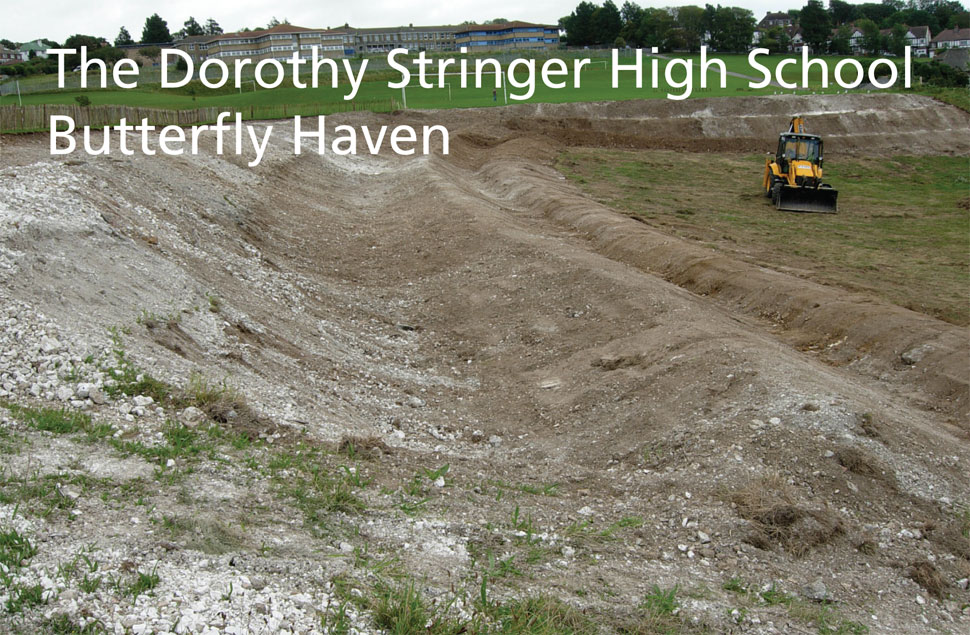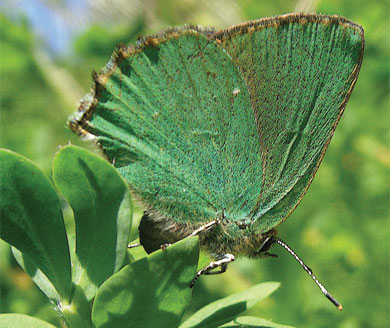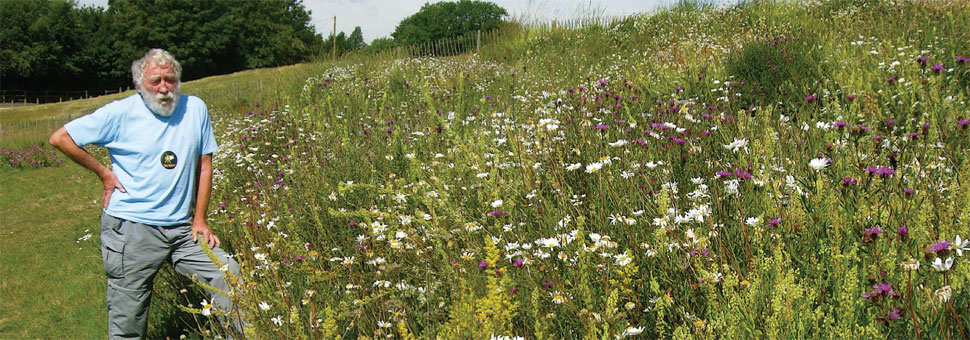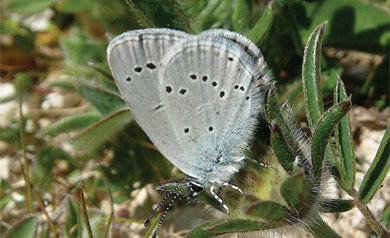The Dorothy Stringer High School Butterfly Haven
Originally published in the Spring 2011 Sussex Butterfly Report
Forward
The construction of the original “Liz Williams” butterfly haven, has given us a lot of insight about how early successional butterfly species move through our chalk grassland landscape. Indeed, if ever there was a good example of how the niche ecology of a group of butterfly species can be so specifically tied to a meta population strategy (for persisting within a dynamic and changing landscape) then its this group.
The success of the butterfly haven/bank approach for habitat restoration of downland butterflies has led to this ecological engineering approach being emulated throughout the region. For the time being please read the article below to have some idea about its origins. However, an update on where this technique has taken us is planned for the 2016 Sussex Butterfly report. So keep an eye open for it!
Dan Danahar, February 2017

In 1994 I became intrigued by an approach to habitat creation with the potential to establish the niche requirements for the majority of our early successional chalk grassland butterflies. The concept came from a paper that looked at the “ecological engineering” potential for chalk grassland. The work was based on observations of ant hill topography and showed how t his could be applied to manipulate micro-climate at ground level1.
This idea then lay dormant until 2006 when the BBC, in conjunction with the National Lottery, launched its Breathing Places scheme. It was clear that an application to create a habitat mosaic for rare downland butterflies would have a high chance of success, simply because it was unusual, and this proved to be the case.
 Ovipositing Green Hairstreak, first recorded at The Butterfly Haven in 2010
Ovipositing Green Hairstreak, first recorded at The Butterfly Haven in 2010
Dorothy Stringer High School (DSHS) is a successful comprehensive school in the city of Brighton and Hove that shares the 28 hectare Surrenden Campus with six other educational institutions. The geology of the site s Seaford Chalk Formation and the majority of the campus is landscaped amenity/municipal grassland. The site for the Butterfly Haven is located on south and west facing slopes, north of Stringer Way (TQ309072) with a total area of no greater than 400 m2. This site and the land adjacent had been managed with the type of intensive mowing regime traditionally associated with the maintenance of sports pitches. Since the winter of 2005/06, this practice was relaxed to a single annual, early autumnal cut. Prior to this change no species of butterfly were known to breed there. In the summer of 2006 both the Meadow Brown (Maniola jurtina) and Common Blue (Polyommatus icarus) colonised the area. In July of 2007, pupils from the school recorded 12 species of wildflower within the existing sward but no attempt was made to identify the grasses to species level.
Initial landscaping took place in August of 2007. Plant machinery was used to remove the nutrient-rich top soil which was deposited at the bottom of the slopes, where the gradient became negligible. The subsoil and chalk bedrock of the slopes were then mixed and formed into a series of parallel “static waves” or banks. This process turned the formerly south facing slope into a north/south facing one and the corresponding west facing slope into a west/east facing feature. This stage of the work was completed within two and a half weeks and cost approximately £3500.
 Adonis Blue, first recorded at The Butterfly Haven in 2010
Adonis Blue, first recorded at The Butterfly Haven in 2010
During the winter of 2007/08 every child from DSHS (1700 in total) was given the opportunity to participate in the planting of 5500 wildflower plants of 18 species grown from locally collected seed. In early April 2008 a small group of pupils and teachers sowed 20 kg of seed (EM6 - meadow mixture for chalk and limestone soils) purchased from Emorsgate Seeds, which cost £918.53. This mix contained 21 wildflower species and 7 species of grass. The seed was sown in strips so that comparisons could be made between where the seed had and had not been sown, and so that some areas of bare chalk would be left for the thermophilous (warmth-loving) butterflies we were keen to attract.
By September 2008 the late Liz Williams, botanist, had recorded 97 wildflower species and 10 species of grass. This was an order of magnitude increase in the floral diversity of the site within one year. As a tribute to her work, the site will be renamed the Liz Williams Butterfly Haven during 2011.
Since 2008, the site has been grazed during one week of every winter with sheep owned by the Sussex Wildlife Trust.
A list of twenty butterfly species has been recorded in the Butterfly Haven between 2006 and 2010 and this represents a dramatic increase in species richness. Ten of these species were breeding on the site by 2010. In addition to the pre-existing colonies of the Meadow Brown and Common Blue, in the summer of 2008 colonies of Essex Skipper (Thymelicus lineola) and Small Copper (Lycaena phlaeas) established themselves. During 2009 the Brown Argus (Aricia agestis), Gatekeeper (Pyronia tithonus) and Painted Lady (Vanessa cardui) moved onto the site as new breeding species.
 Professor David Bellamy OBE visiting The Butterfly haven in the summer of 2010
Professor David Bellamy OBE visiting The Butterfly haven in the summer of 2010
On a Sussex Biological Records Centre recording day in June 2009, Jim Steedman & Graeme Lyons discovered two egg-laying Small Blues (Cupido minimus). The original Emorsgate seed mix, sown in 2007, contained just 1.5% Kidney Vetch (Anthyllis vulneraria) the food plant of the Small Blue. In 2008 the resultant sward looked like the mix had contained 70% Kidney Vetch because it was the most dominant species. The nearest known colony of Small Blue is 3 km away, although I believe that there must be some nearer than this. One possible explanation for this phenomenon is that the Small Blue can use its directional olfactory organs (antennae) to detect the secondary metabolic compounds released by the food plant. In 2010 this was the most common species on the Butterfly Haven, during its first brood.
 Small Blue, first recorded here in 2009 and one of the commonest butterflies in 2010
Small Blue, first recorded here in 2009 and one of the commonest butterflies in 2010
It was also during 2010 that four new species where seen on the site: Adonis Blue (Polyommatus bellargus), Chalkhill Blue (Polyommatus coridon), Green Hairstreak (Callophrys rubi) and Marbled White (Melanargia galathea). Both Adonis Blue and Green Hairstreak may be in the process of starting colonies on the site2. The nearest known colony of Adonis Blue is 2 km away which contradicts the conventional views about the dispersal mechanisms available to this species3.
Butterflies have been used as a flagship group during the creation of the Butterfly Haven, to demonstrate what can be done to raise the biodiversity on the Surrenden Campus. Sympathetic management and appropriate “ecological engineering” has created a surrogate habitat as opposed to a recreation of chalk grassland. A sufficient number of this semi-natural habitat’s key elements have been reproduced to cater for the niche requirements of early successional chalk grassland species4. Brighton & Hove City Council is now looking to replicate elements of this work within the parks and open spaces of the city. This is because it demonstrates the potential for combating the problems associated with chalk grassland fragmentation for meta-populations of species like early successional chalk grassland butterflies.
References
1. Morris, M. G. et al. (1994) Re-creation of Early-successional Stages for Threatened Butterflies - an Ecological Engineering Approach, Journal of Environmental Management 42, 119-135.
2. www.sussex-butterflies.org.uk Butterfly Conservation Sussex Branch,
3. Thomas, J. A. (1983) The ecology and conservation of Lysandra bellargus (Lepidoptera: Lyceanidae) in Britain. Journal of Applied Ecology, 20, 59-83.
4. Butterflies Under Threat Team (1986) The management of chalk grassland for butterflies, Focus on nature conservation, No. 17, Nature Conservancy Council.


